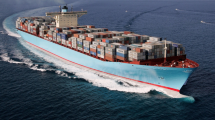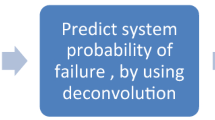Abstract
This paper deals with reliability analysis of ships under vector-load processes. Failure is expressed by multiple response variables. Different methods can be used to assess failure probability, primary among them are the time-independent and out-crossing (up-crossing) rate methods. This paper describes the procedure for performing reliability analysis of ships under vector-load processes by the out-crossing rate method. Alternative methods based on piecewise linear or continuous modeling of failure surface are explored for calculating the out-crossing rate and compared. The methods are exemplified by calculating the conditional probability of a damaged double hull oil tanker under combined vertical and horizontal bending moments.














Similar content being viewed by others
References
Abrahamsen E, Nordenstrom N, Røren EMQ (1970) Design and reliability of ship structures. In: Proceedings of Spring Meeting, SNAME
Mansour AE (1972) Probabilistic design concepts in ship structural safety and reliability. Trans SNAME 80:64–97
Mansour AE, Harding S, Zigelman C (1984) Implementation of reliability methods to marine structures. Trans SNAME 92:353–382
Guedes Soares C, Parunov J (2006) Structural reliability of a SUEZMAX oil tanker designed according to New Joint Tanker Project Rules. In: The 25th international conference on offshore mechanics and arctic engineering, June 4–9, Hamburg, Germany
Moan T, Shu Z, Drummen I, Amlashi H (2006) Comparative reliability analysis of ships-considering different ship types and the effect of ship operations on loads. Annual Meeting (SMTC&E), SNAME, Fort Lauderdale
Fang C, Das PK (2005) Survivability and reliability of damaged ships after collision and grounding. Ocean Eng 32:293–307
Luis RM, Teixeira AP, Guedes Soares C (2006) Longitudinal strength reliability of a tanker accidentally grounded. Safety and reliability for managing risk. Taylor & Francis Group, London
Mano H, Kawabe H, Iwakaes K, Mitsumune N (1977) Statistical character of the demand on longitudinal strength (second report)-long term distribution of still-water bending moment. J Soc Naval Arch Jpn 142:255–263
Guedes Soares C, Moan T (1985) Uncertainty analysis and code calibration of the primary load effects in ship structures. In: Fourth international conference on structural safety and reliability, vol 3, pp 501–512
Moan T, Jiao G (1988) Characteristic still-water load effects for production ships. Report MK/R 104/88, The Norwegian Institute of Technology, Trondheim, Norway
Guedes Soares C (1992) Combination of primary load effects in ship structures. Prob Eng Mech 7:103–111
Wang X, Moan T (1996) Stochastic and deterministic combinations of still water and wave bending moments in ships. Marine Struct 9:787–810
Huang W, Moan T (2005) Combination of global still-water and wave load effects for reliability-based design of floating production, storage and offloading (FPSO) vessels. Appl Ocean Res 17:127–141
Huang W, Moan T (2008) Analytical method of combining global longitudinal loads for ocean-going ships. Prob Eng Mech 23:64–75
Guedes Soares C (1993) Long-term distribution of non-linear wave induced vertical bending moments. Marine Struct 6:475–483
Guedes Soares C, Schellin TE (1996) Long-term distribution of non-linear wave induced vertical bending moments on a containership. Marine Struct 9:333–352
Bjerager P, Løseth R, Winterstein SR, Cornell CA (1988) Reliability method for marine structures under multiple environmental load processes. In: Proceedings of the international conference on behavior of offshore structures, June, Trondheim, pp 1239–1253
Melchers RE (1999) Structural reliability analysis and prediction, chap 6. Wiley, England
Videiro PM (1998) Reliability based design of marine structures. Ph.D. thesis, NTNU, Trondheim
Rice SO (1954) Mathematical analysis of random noise. In: Nelson Wax (ed) Selected papers and noise and stochastic processes, Dover, New York
Naess A, Gaidai O (2007) The asymptotic behavior of second-order stochastic volterra series models of slow drift response. Prob Eng Mech 22:343–352
Naess A (1983) Prediction of extremes of Morison-type loading-an example of a general method. Ocean Eng 10(5):313–324
Bender CM, Orszag SA (1978) Advanced mathematical methods for scientists and engineers, chap 6. McGraw-Hill, New York
Vinje T (1980) Statistical distributions of hydrodynamic forces on objects in current and waves. Norwegian Marit Res 8(2):20–26
Belyaev YK (1968) On the number of exits across the boundary of a region by a vector stochastic process. Theory Prob Appl 13:320–324
Ditlevsen O (1973) Structural reliability and the invariance problem. Research report no. 22, Solid Mechanics Division, University of Waterloo, Waterloo, Canada
Hasofer AM (1974) The upcrossing rate of a class of stochastic processes. In: Williams EJ (ed) Studies in probability and statistics, Jerusalem Academic Press, Jerusalem, pp 153–170
Veneziano D, Grigoriu M, Cornell CA (1977) Vector-process models for system reliability. J Eng Mech Div ASCE 103(3):441–460
Leira BJ (1985) Probabilistic design—a level 3 Study. STF71 A85004, SINTEF, Trondheim
Leira BJ, Moan T (1987) Extremes of combined load effects for design of gravity platforms. OMAE, Houston
Wen YK, Chen H-C (1987) On fast integration for time variant structural reliability. Prob Eng Mech 2(3):156–162
Moan T et al (1994) Applied design strength limit states formulations. Report of ISSC Committee V.1, In: Proceeding of 12th ISSC, St. John’s Newfoundland
Jia H, Moan T (2008) Reliability analysis of oil tankers with collision damage. OMAE2008-57102
IACS (2006) Common structural rules for double hull oil tankers, Appendix A, Sect. 2.3
Moan T (1996) Structural reliability analysis, Lecture Notes, chap 6
Author information
Authors and Affiliations
Corresponding author
Additional information
An erratum to this article can be found at http://dx.doi.org/10.1007/s00773-010-0101-2
Appendices
Appendix I: Up-crossing rate by Naess’s method for a problem with limit state defined by Eq. 29
where \( {\mathbf{Q}}(t) = \left\{ {X(t),Y(t)} \right\}^{T} = \left\{ {{\frac{{M_{v} (t)}}{{M_{uv} }}},{\frac{{M_{h} (t)}}{{M_{uh} }}}} \right\}^{T} \)
From Eq. 32, we can derive that
Write the mean vector of Q as μ Q and the covariance matrix Σ of \( \left( {{\mathbf{Q}}^{T} ,{\dot{\mathbf{Q}}}^{T} } \right)^{T} \) as
Given \( {\mathbf{Q}} = {\mathbf{q}} = (x,y)^{T} \), the joint PDF of \( \dot{Q} \), is multivariate normal with mean value \( {\varvec{\upmu}}_{c} = {\varvec{\Upsigma}}_{21} {\varvec{\Upsigma}}_{11}^{ - 1} ({\mathbf{q}} - {\varvec{\upmu}}_{Q} ) = (\mu_{1} ,\mu_{2} )^{T} \) and covariance matrix \( {\varvec{\Upxi}} = {\varvec{\Upsigma}}_{22} - {\varvec{\Upsigma}}_{21} {\varvec{\Upsigma}}_{11}^{ - 1} {\varvec{\Upsigma}}_{12} . \) Hence the statistics of \( \{ \dot{H}|{\mathbf{Q}} = {\mathbf{q}}\} \) are given as:
where \( {\mathbf{p}}^{T} = \left[ {\alpha x^{\alpha - 1} ,\beta y^{\beta - 1} } \right] \)
Furthermore,
Equation 20 becomes:
where ~ indicates that \( x = x(y,\xi ). \) Set
\( f_{1} = {\frac{1}{\alpha }}\tilde{x}^{1 - \alpha } ,\;f_{2} = \left[ {\tilde{\sigma }\phi \left( {{\frac{{\tilde{\mu }}}{{\tilde{\sigma }}}}} \right) + \tilde{\mu }\Upphi \left( {{\frac{{\tilde{\mu }}}{{\tilde{\sigma }}}}} \right)} \right],f_{3} = {\frac{1}{{2\pi \sqrt {\left| {{\varvec{\Upsigma}}_{11} } \right|} }}}\exp \left( { - {\frac{1}{2}}({\tilde{\mathbf{q}}} - {\varvec{\upmu}}_{Q} )^{T} {\varvec{\Upsigma}}_{11}^{ - 1} ({\tilde{\mathbf{q}}} - {\varvec{\upmu}}_{Q} )} \right), \) and f t = f1 · f2 · f3,
For the limit surface given in Eq. 29, the out-crossing rate is given by Eq. 39 with level ξ = 1. The integration in Eq. 39 could be evaluated numerically. However, an asymptotic evaluation for high level mean up-crossing can also be achieved by the generalized Laplace method.
Appendix II: asymptotic evaluation of high level mean up-crossing rate defined by Eq. 39
To calculate the asymptotic mean up-crossing rate by the Laplace method, Eq. 39 should be simplified first. The following variables are defined, \( c(y) = {\frac{1}{2}}\left( {{\tilde{\mathbf{q}}} - {\varvec{\upmu}}_{Q} } \right)^{T} {\varvec{\Upsigma}}_{11}^{ - 1} \left( {{\tilde{\mathbf{q}}} - {\varvec{\upmu}}_{Q} } \right),a(y) = \alpha \tilde{x}^{\alpha - 1} \) and \( b(y) = {\frac{{\tilde{\sigma }}}{{\text{cov} (\dot{X},Y)a(y)}}}, \) then
Integration by parts on the second term of Eq. 43 gives:
Set \( f(y,\xi ) = b + {\frac{c''}{b}} - {\frac{c'b'}{{b^{2} }}} \) and \( k(y,\xi ) = c + {\frac{1}{2}}\left( {{\frac{c'}{b}}} \right)^{2} \). The integration in Eq. 44 can be calculated by the Laplace method which gives the asymptotic evaluation of the integration involving a large quantity ξ as following:
where y 0 is found numerically to give the global minimum of k(y, ξ) within the integration interval [y l , y u ] and f(y 0, ξ) ≠ 0. Notice that
If c(y, ξ) and k(y, ξ) have the same global minimum, the right hand side of Eq. 45 becomes:
Then the asymptotic mean up-crossing rate can be calculated using Eqs. 44 and 47.
About this article
Cite this article
Jia, H., Moan, T. Comparative reliability analysis of ships under vector-load processes. J Mar Sci Technol 14, 485–498 (2009). https://doi.org/10.1007/s00773-009-0061-6
Received:
Accepted:
Published:
Issue Date:
DOI: https://doi.org/10.1007/s00773-009-0061-6




